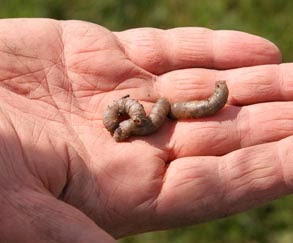September is the traditional time for Daddy Longlegs or Crane Flies (Tipula oleracea). They mostly live in grassland, which includes domestic lawns, but they are also attracted to light so you may find them in your house on warm evenings when the windows are open. They get stuck in the top corners of tents too if you are camping at this time of year.
The reason they like grassland is that that is where they lay their eggs. The females have a pointed end to their bodies so that they can place the eggs underground where the grass roots are. This pointy bit is called an ovipositor which means "egg-placer".
The male bodies have a square end so you can easily tell Daddy Longlegs and Mummy Longlegs apart.
The larvae that hatch from these eggs are called leatherjackets and look a bit like greyish caterpillars. They can cause damage to lawns by eating the roots. They also help to recycle decaying matter in the ground, chomping away underground through autumn, winter and spring.
Then out they pop in September again for two weeks of adult activity - mating, egg-laying and aerial dancing. They may eat a bit of nectar but most just live off their accumulated fat and fade away. It's a bit sad really. Nobody likes them much, except hungry birds and spiders - and their mates of course
Photo: UK Wildlife
One especially interesting feature visible on a Crane Fly is the pair of halteres. These are two strange little drumstick shaped organs just behind the wings. Most insects have four wings but flies have only two. That is what the name of their order Diptera (flies) means: 'two-wings.' So instead of a second pair of wings, flies have these halteres. It is thought that they are modified hind-wings, which perhaps help with balance. In Crane Flies they are particularly easy to see.
To avoid confusion, especially for our readers in USA and Canada, the name Daddy Longlegs is also sometimes applied to Harvestmen (Opiliones), which are a very spindly-legged group related to spiders.
And it is also sometimes used for the Cobweb Spider (Pholcus phalangioides and its relatives), especially in Australia, apparently.
Photos from various sources. I'm afraid I can't remember where but thank you.







No comments:
Post a Comment
I just love getting comments so go ahead.